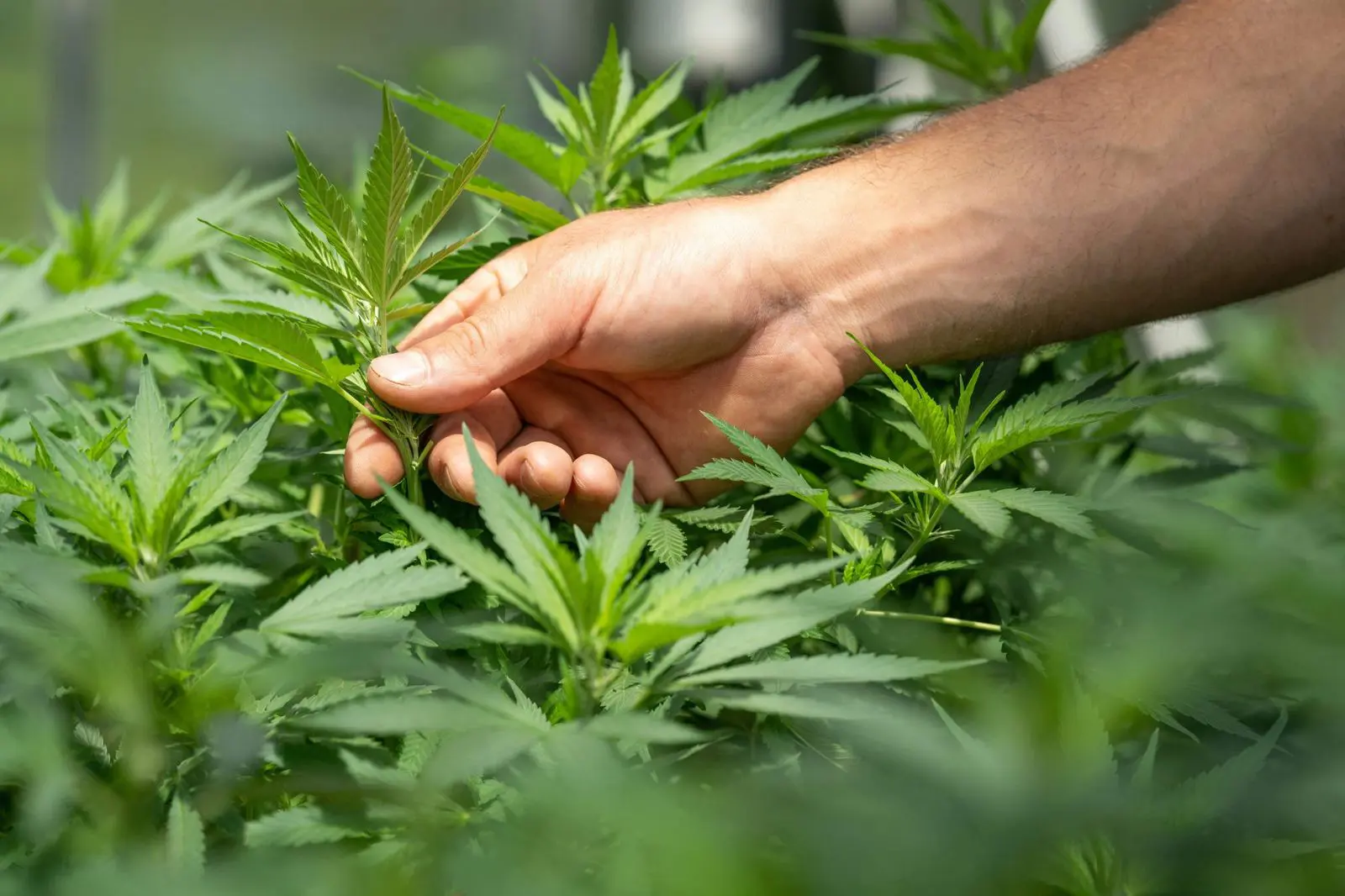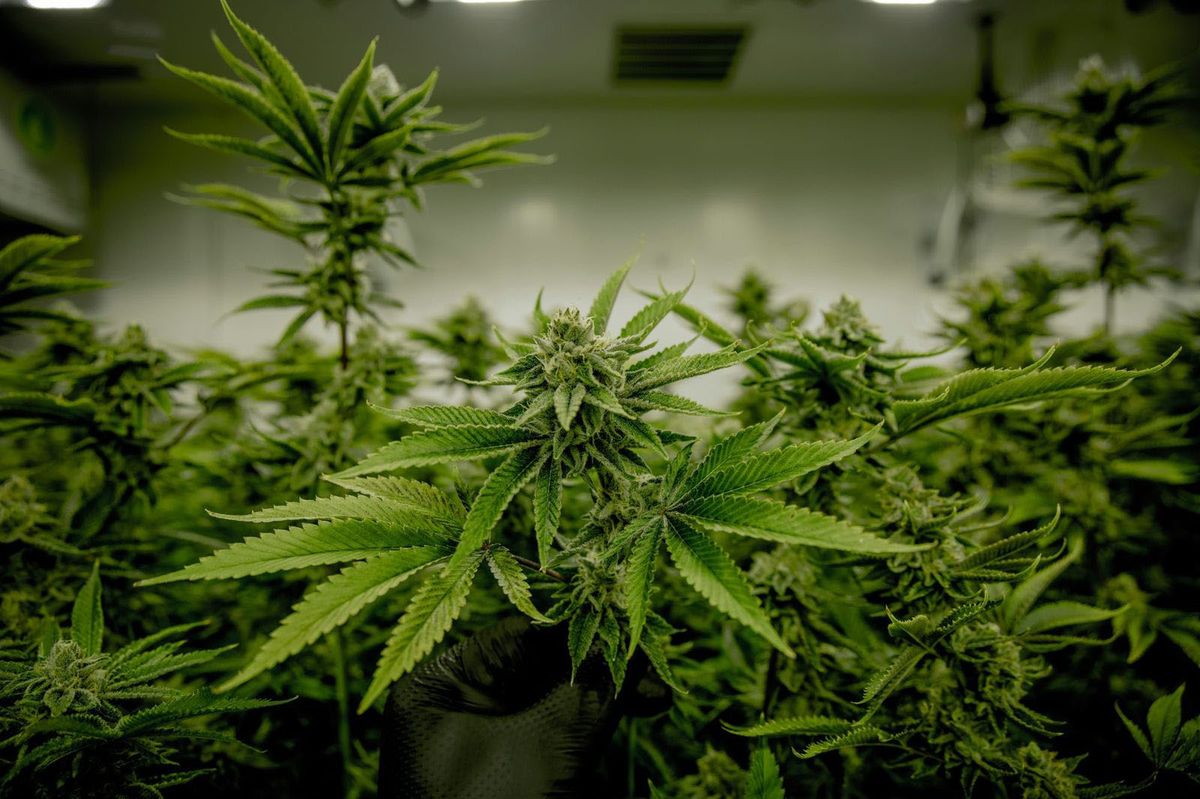Learn to master the art of cannabis transplanting and unlock the secrets to a thriving harvest through careful timing and expert considerations for growers.
Transplanting cannabis is a delicate process that requires careful consideration and timing. It is a pivotal moment in the life cycle of your plants, and getting it right can mean the difference between a thriving harvest and a disappointing yield. Whether you’re a seasoned grower or just starting out, today’s blog post will help you master the delicate balance of when to transplant cannabis and provide you with the knowledge and insights needed to navigate through a proper cultivation operation plan.
4 Reasons Why Cultivators Transplant Cannabis Plants

1. Separating Male and Female Cannabis Plants
One of the primary reasons for transplanting cannabis plants is to separate the male plants from the female plants. As the plants mature, the males produce small, round pollen sacs, while females develop tiny white pistils. By transplanting the males to a different location, growers can prevent them from pollinating the females and producing seeded buds.
The scientific background for this practice lies in the reproductive biology of cannabis. Cannabis plants are dioecious, which means they have separate male and female individuals. The female plants are the ones that produce the resinous flowers rich in cannabinoids, while the males produce pollen to fertilize the female flowers. When the female plants are pollinated, they redirect their energy towards seed production instead of resin production. This results in lower potency and reduced quality of the buds.
2. More Room to Grow
Transplanting cannabis plants into larger containers or raised beds provides the roots with more space to expand. This additional room allows the roots to develop a stronger and more extensive root system, leading to improved nutrient absorption and overall plant health.
Scientifically, this practice benefits the cannabis plants in multiple ways. First, a larger root system enables the plant to access a larger volume of soil, which is rich in essential nutrients. This increased nutrient availability promotes healthy growth and development, resulting in larger and higher-quality buds.
3. Changing the Growing Environment
Cultivators often transplant cannabis plants to change the growing environment. This practice allows growers to adapt to different conditions and optimize the plant’s growth and development.
For example, some cultivators start their plants indoors under controlled conditions and then transplant them outside when the weather is appropriate. This transition from an indoor environment to an outdoor one exposes the plants to natural sunlight, fresh air, and the benefits of being directly in the ground. These factors can enhance the plant’s growth and improve its overall health.
4. Speed of Growth
Transplanting cannabis plants at the right time can help maintain their optimal growth rate. If a plant is outgrowing its current pot, it may become root-bound, leading to stunted growth. By transplanting before this happens, cultivators ensure that the plant has enough room to continue growing at its maximum potential.
Scientifically, this practice is rooted in the understanding of the plant’s root system. Cannabis plants rely on a healthy and well-developed root system to absorb water, nutrients, and oxygen from the soil. If the roots become constrained in a small pot, their growth becomes limited, and the plant’s overall growth rate slows down.
Why is Transplanting Cannabis Plants Important?
When it comes to cultivating cannabis, transplanting is a vital step that can greatly impact the output, longevity, and quality of the plants. Understanding when to transplant cannabis is critical for a successful harvest. Let’s explore what happens if cannabis cultivators neglect this crucial process and the consequences it can have on their plants.

1. Enhanced Root Development
Transplanting cannabis plants at the right time allows for enhanced root development. When a plant outgrows its current container, its root system becomes restricted, leading to a congested and tangled root mass. This limits the plant’s ability to absorb nutrients and water effectively, resulting in stunted growth and reduced yield potential.
2. Preventing Root Bound Conditions
Neglecting transplanting can cause cannabis plants to become root-bound, with tangled roots hindering nutrient uptake and water absorption, impacting overall health.
The cramped root system makes plants more susceptible to disease and pests, as highlighted in this guide from agri.nv.gov on Hemp and Cannabis Diseases. Tightly packed roots create an environment conducive to these issues. Transplanting is crucial to prevent such problems and ensure the optimal growth and vitality of cannabis plants.
3. Increased Nutrient Uptake
Transplanting cannabis plants promotes nutrient uptake by providing more space for essential elements. In root-bound conditions, limited space hinders nutrient availability, leading to issues like yellowing leaves and stunted growth. Larger containers during transplanting ensure ample soil volume, allowing plants to access the necessary nutrients for vibrant foliage, robust growth, and abundant flower production.
4. Minimized Stress and Shock
When to transplant cannabis: Transplanting cannabis plants at the right time minimizes stress and shock, crucial for their overall well-being. This proactive approach ensures that plants in their optimal growth phase are more resilient and adaptable to the transplantation process, especially when facing other environmental challenges. By reducing stress, cultivators enable uninterrupted growth, fostering healthier and higher-quality cannabis plants.
5. Improved Airflow and Moisture Regulation
Transplanting cannabis plants into larger containers enhances airflow and moisture regulation, crucial for preventing issues like root rot and fungal diseases. The increased space allows for better ventilation, reducing the risk of moisture-related problems and promoting healthier root systems. This practice is essential for ensuring the longevity and quality of cannabis plants by addressing the limitations of small containers.
Pro-Tip for Cannabis Cultivators
A seed-to-sale software is a powerful tool that cultivators can use to streamline and optimize their cannabis plant growth process. This software provides cultivators with a holistic platform to track all aspects of the cultivation cycle, from planting seeds to selling the final product.

Did you know? GrowerIQ has an industry-leading Seed-to-Sale Cannabis Software (with quality management built in) that is designed to uncomplicate cannabis production for cannabis producers throughout the world.
When to Transplant Cannabis?
Knowing exactly when to transplant cannabis is one of the most critical decisions a cultivator can make. Transplanting at the wrong time can stunt plant development, cause unnecessary stress, and ultimately reduce your final yield. Understanding the optimal timing ensures your plants thrive through every growth phase and sets the foundation for a healthy harvest.

Transplanting Cannabis During the Vegetative Stage
The vegetative stage, which typically occurs around 2-4 weeks after germination, is the perfect time to transplant your cannabis plants. During this stage, the plants are focused on growing leaves, stems, and branches, rather than developing buds. By transplanting during the vegetative stage, you give your plants the opportunity to adjust to their new environment before they enter the flowering stage.
Stress Reduction
Understanding when to transplant cannabis includes recognizing that the vegetative stage is the safest window. During this phase, typically 2–4 weeks after germination, plants are actively growing foliage and can better tolerate the move. Transplanting now minimizes stress, allows root systems to settle, and helps your crop transition smoothly into flowering with strength and resilience.
Reading the Signs in Leaf Size and Plant Shape
Deciding when to transplant cannabis isn’t just about counting days; it’s about reading your plant. Look for signs like crowded leaf formations, bushy growth, or limited canopy space. These are visual cues that your plant needs a larger container to stretch its roots and maintain vigorous growth. By aligning visual indicators with optimal transplant timing, you avoid stunted development and keep your crop on track.
Root Health Signals
Another indicator to look out for is the condition of the roots. If you see roots starting to grow out of the drainage holes or if they appear to be tightly packed in the current container, it’s a clear sign that your plant has outgrown its current home. Transplanting at this stage will prevent the roots from becoming root-bound and stunting the plant’s growth.
How Much Space Does a Cannabis Plant Need?
The space in which a cannabis plant grows plays a crucial role in its overall health and productivity. Providing each plant with a minimum of 3-4 square feet of grow space is essential to ensure optimal growth and yield. Let’s explore why this is the case:
1. Sufficient room for root development
Cannabis plants have an extensive root system that requires ample space to spread and grow. By allowing each plant to have 3-4 square feet of grow space, we provide enough room for the roots to expand and establish a strong foundation. This promotes better nutrient uptake, enhanced water absorption, and overall healthier plants.
2. Prevention of overcrowding
Crowded grow spaces can lead to a range of issues, including poor air circulation, increased humidity, and the spread of diseases and pests. By allocating adequate space, we can reduce the risk of these problems and create a more favourable environment for the plants to thrive. Improved airflow helps prevent the buildup of excess moisture, reducing the likelihood of mould and mildew formation.
3. Access to light
Cannabis plants require an ample amount of light to undergo photosynthesis, the process by which they convert light energy into chemical energy. By providing each plant with its own designated space, we ensure that light can reach every part of the plant, from the top canopy to the lower leaves. This allows for more even distribution of light, maximizing the plant’s ability to produce energy and grow efficiently.
4. Reduced competition for resources
When cannabis plants are crowded together, they have to compete for essential resources such as water, nutrients, and carbon dioxide. By giving each plant its own space, we eliminate or minimize this competition. This allows each plant to access the necessary resources it needs without being hindered by neighbouring plants. The result is improved overall plant health, greater nutrient uptake, and enhanced growth rates.
5. Easier maintenance and monitoring
Having a sufficient amount of grow space per plant makes it easier to maintain and monitor each plant. This includes tasks such as pruning, training, pest control, and disease prevention. With enough room to maneuver around the plants, cultivators can carry out these tasks with greater ease, accuracy, and efficiency. This ultimately leads to healthier plants and higher yields.
How to Transplant Cannabis, in 6 Steps

1. Moisture Matters: Watering Seedlings Prior to Transplanting
Before transplanting your cannabis seedling, it is crucial to ensure that the soil is adequately moist. Water the plants 1-2 days before the transplant, but be cautious not to make the soil excessively wet. The goal is to strike a balance, providing enough moisture to keep the roots hydrated and healthy without causing waterlogged conditions.
2. Choosing the Right Potting Mix: Preparing the New Pot
Select a high-quality potting mix that provides the necessary nutrients and proper drainage for your cannabis plants. Fill the new pot with the soil, leaving some space at the top. Avoid overpacking the soil, as it can hinder root growth and water absorption. Once filled, water the new pot to provide a favourable environment for the transplant.
3. Gently Handling the Seedling: Flipping and Supporting the Plant
To transplant your cannabis seedling, cover the soil in the old pot with your hand, making sure the plant protrudes between your fingers. Carefully flip the pot over, ensuring the plant remains intact. Support the plant with your hand to avoid damage during the process.
4. Removing the Root Ball: Ensuring a Smooth Transition
To remove the root ball from the old container, exercise caution and patience. If the root ball doesn’t come out easily, gently squeeze and pat the sides of the pot to loosen the soil. If the root ball still won’t budge, lay the pot horizontally on the floor and try sliding it out. If all else fails, as a last resort, use a knife to cut around the outer rim of the soil. Excessive force can harm the roots, so be gentle!
5. Placing the Plant: Transferring to the New Container
Once the plant is free from the old container, support the root ball with your hand and carefully transfer it to the hole prepared in the new pot. Use additional soil to fill any gaps around the root ball, ensuring it is securely positioned. Lightly pat down the soil to maintain stability while avoiding excessive compaction.
6. Settling into the New Home: Watering and Nurturing the Transplant
After transplanting, lightly water the plant to help it settle and adapt to its new surroundings. This is an ideal time to use a root stimulator, which can assist in reducing transplant shock and encouraging root development. By providing the necessary nutrients and hydration, you are setting the stage for your cannabis plant to thrive.
How GrowerIQ helps Cultivators Improve their Crop Quality
Cultivating cannabis is a complex and highly regulated process that requires meticulous attention to detail and adherence to strict guidelines. GrowerIQ is a comprehensive platform that brings together various essential elements of cannabis cultivation operations, including compliance, cultivation, manufacturing, quality management system (QMS), and customer relationship management (CRM). By combining all these functionalities in one easy-to-use platform, GrowerIQ empowers cannabis operators globally to enhance their crop quality and improve quality control.

Compliance Made Easy
Ensuring compliance with ever-evolving regulations is a critical aspect of any cannabis cultivation operation. GrowerIQ simplifies the compliance process by providing cultivators with tools and features designed specifically to meet regulatory requirements.
The platform enables operators to track and document all cultivation activities, monitor inventory, and generate reports effortlessly. With GrowerIQ, cultivators can stay ahead of compliance changes, reduce the risk of non-compliance, and maintain a strong relationship with regulatory authorities.
Cultivation Optimization
Cultivation is the heart of the cannabis operation, and GrowerIQ is built to optimize this crucial process. The platform provides cultivators with real-time visibility and control over every aspect of their cultivation operations. Growers can monitor temperature, humidity, lighting, and other environmental factors, ensuring the ideal conditions for plant growth. By leveraging GrowerIQ’s advanced analytics and machine learning capabilities, cultivators can make data-driven decisions to improve crop yield, potency, and overall quality.
Streamlined Manufacturing
The manufacturing process of cannabis products involves a series of steps, from extraction to packaging. GrowerIQ streamlines this entire process, allowing operators to manage and track each manufacturing stage seamlessly. With the platform’s manufacturing module, cultivators can optimize workflows, monitor product quality, and ensure consistency in their product offerings.
GrowerIQ’s integration with compliance and QMS modules ensures that every step of the manufacturing process meets regulatory requirements and maintains the highest quality standards.
Quality Management System (QMS)
Ensuring consistent product quality is crucial for any cannabis cultivator. GrowerIQ’s QMS module provides cultivators with the tools to implement and maintain robust quality control practices. The platform allows operators to track and trace every plant and product, ensuring full visibility throughout the supply chain. GrowerIQ’s QMS module also enables cultivators to perform quality inspections, manage non-conformances, and implement corrective and preventive actions (CAPAs) to continuously improve product quality.
Nurturing Customer Relationships
Building and maintaining strong relationships with customers is essential for long-term success in the cannabis industry. GrowerIQ’s CRM module helps cultivators nurture these relationships by providing a centralized platform for customer data management and communication. The platform allows operators to track customer preferences, manage orders, and provide personalized experiences. By leveraging GrowerIQ’s CRM module, cultivators can enhance customer satisfaction, loyalty, and ultimately, grow their business.
Discover how GrowerIQ’s seed-to-sale software can help you set up all of the administrative components of a successful cannabis cultivation operation, without any hassle. Questions we haven’t covered? Please reach out and let us know. GrowerIQ serves clients coast to coast, and we’re ready to help your team today.
Latest Posts
Streamline Cannabis CultivationRecommended For You
Revolutionizing Efficiency: How Production Management Software Transforms Creative Industries into Powerhouses
January 2, 2026Unlock the Secret to Thriving Greenery: Discover the Best Organic Fertilizer for Seedlings Today!
December 30, 2025Cannabis Conventions: Where Innovation Meets Culture in the Heart of the Green Revolution
December 29, 2025About GrowerIQ
GrowerIQ is changing the way producers use software - transforming a regulatory requirement into a robust platform to learn, analyze, and improve performance.
To find out more about GrowerIQ and how we can help, fill out the form to the right, start a chat, or contact us.




